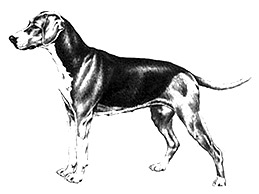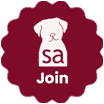Breed standards
Hamiltonstovare
Breed standards are the official guidelines that describe the ideal characteristics, temperament, and appearance of a breed and ensures that the breed is fit for function with soundness essential.

Kennel Club, London 1994
Well proportioned, giving impression of great strength and stamina.
Handsome, upstanding dog of striking colouring. Hardy and sound.
Typical even tempered hound.
Head longish, rectangular, with slightly arched and moderately broad skull. Occiput not too prominent. Stop well defined but not over pronounced. Jowls not too heavy. Muzzle fairly long, large and rectangular. Bridge of nose straight and parallel to line of skull. Nose always black, well developed with large nostrils. Upper lips full but not too overhanging.
Clear and dark brown with tranquil expression.
Set fairly high, when drawn alongside jaw, ears extend to approximately half-way along muzzle and should be raised only slightly above skull when responding to call. Soft with straight fall and fore edge not folded out.
Jaws strong, with perfect, regular and complete scissor bite, i.e. the upper teeth closely overlapping the lower teeth and set square to the jaws.
Long and powerful, merging well into shoulders, skin on neck supple and close fitting.
Shoulders muscular and well laid back. When viewed from front forelegs appear straight and parallel. Upper foreleg long and broad and set at a right angle to shoulder blade. Elbows set close in to body.
Back straight and powerful. Strong, broad, muscular loin. Croup slightly inclined. Chest deep, ribs moderately sprung, back ribs proportionately long. Belly slightly tucked up.
Strong and parallel when viewed from behind. Well angulated, muscle well developed and broad when seen from side.
Short and hard. Pads firm and pointing straight forward. Dew claws only allowed on front legs.
Set on low, in an almost straight continuation of line of back. In length reaches the hock. Fairly wide at base and narrowing off towards tip. Held in a straight position or curving slightly in sabre like shape. Not carried above the backline when moving.
Free striding and long reaching. Hind legs showing drive. Not moving close behind.
Coat consists of two layers. Undercoat short, close and soft, especially thick during winter. Upper coat strongly weather resistant lying close to body. On underside of tail, ordinary hair quite long but not forming a fringe. Ample hair between pads.
Upper side of neck, back, sides of trunk and upper side of tail black. Head and legs, as well as side of neck, trunk and tail brown. White markings as follows; blaze on upper part of muzzle, underside of neck, breast and tip of tail, lower legs and feet. A mixture of black and brown undesirable, as is a preponderance of any of the three permissible colours.
Dogs 53-61 cm (21-24 ins). Ideal size 57 cms (22.5 ins)
Bitches 49-57 cm (19.25-22.5 ins). Ideal size 53 cm (21 ins)
Any departure from the foregoing points should be considered a fault and the seriousness with which the fault should be regarded should be in exact proportion to its degree and its effect upon the health and welfare of the dog.
Male animals should have two apparently normal testicles fully descended into the scrotum.

